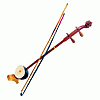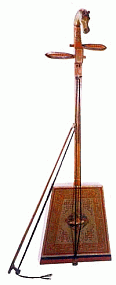|
|
| Chinese
Music |
Bowed Chinese
Musical Instruments |
|
This page covers the most
popular Chinese instruments that are (Normally) played
using a bow. Specifically: They are either played with
a bow, and/or have 2-strings. This family of instruments
is known as 'Huqin', although there is no actual 'Huqin'
instrument in it's own right. Please consider the 'Erhu'
to be the default instrument
Our main information resource remains the very reliable
Wikipedia:
http://en.wikipedia.org/wiki/List_of_traditional_Chinese_musical_instruments
which is complimented by many others, as referenced
below
For ease of reference we have divided Chinese instruments
into four main categories:
• Strings
• Bowed and 2-stringed (This Page)
• Other
Strings, Lutes and Zithers
• Wind
• Percussion
• Other
Instruments
Free music samples and downloads Comply with International
Copyright criteria, and respect International Property
Rights.
Note: Spelling
Most Chinese instruments are written as two Chinese
characters (Mandarin). Pinyin is a standard way to write
these characters in English. The Chinese would write
these as one English word in lower case. Westerners
tend to Capitalise the words. Other Western spellings
sometimes exist, especially changing 'qin' to 'ching'
etc. We use the standard letters as approved by Beijing,
and generally Capitalised the first letters of both
Chinese words (For correct syntax)
Strings
Bowed and 2-stringed Instruments (Huqin):
| Instrument |
Brief Description |
Listen |
| |
|
|
| Huqin |
|
|
 |
Hu Qin refers to a group of
Chinese instruments played with a bow. There is
not a specific instrument called a HuQin
Hu means 'Foreign' or 'Barbarian' (Probably referring
to an ancient Northern nomadic people called the
'Xi'). Today both Qin and HuQin mean 'Stringed
musical instrument'
more...
|
No
Link |
| HuQin |
|
|
| |
|
|
| Banhu |
|
|
 |
Banhu (Wood Faced Fiddle)
Its name comes from the wooden soundboard covering
the half globular resonating coconut chamber.
Of its many other names the most prominent may
be banhu, referring to its historical use in the
northern bangzi opera in the mid-seventeenth century.
From them on it came to accompany many other regional
operas and popular narratives, spreading over
north, northwest and northeast China. That betrays
the origin of its strong local opera styles.
The two strings are generally tuned a fifth, or
a fourth, apart. Strident and bight in tone quality
and characteristic of glissando, the banhu is
used as a solo instrument and one of the bowed
strings in the modern Chinese orchestra.
Please visit our new Banhu page wich offers a
full description with pictures, and many tracks
for free download more...
|
External
Link |
| |
|
| |
|
|
| Dahu |
|
|
 |
The dahu (大胡, pinyin: dàhú) is
a large bowed string instrument from China. It
has a large soundbox covered on one end with python
skin. Like most other members of the huqin family
of instruments, it has two strings and is held
vertically. The instrument is generally pitched
one octave below the erhu, and is considerably
larger than the erhu. Its name derives from the
Chinese word for "large" (dà), and the
word hú (short for huqin). Its bridge is often
placed somewhat above the centre of the snakeskin
to avoid stretching the skin
more...
|
No
Link |
| DaHu |
|
| . |
| Dihu |
|
|
 |
Large Chinese bowed instrument
of the HuQin family. This one is a bass version
giving a three-quarter bass like sound when played
DiHu pictured along with an ErHu
more...
|
No
Link |
| DiHu |
|
| . |
| Erhu |
|
|
 |
Erhu (Second Fiddle)
The erhu (Chinese: 二胡; pinyin: èrhú), also called
nanhu (南胡, "southern fiddle"), and sometimes
known in the West as the "Chinese violin"
or "Chinese two-string fiddle," is a
two-stringed bowed musical instrument, used as
a solo instrument as well as in small ensembles
and large orchestras. It is the most popular instrument
in the huqin (胡琴) family of Chinese bowed string
instruments, together with the zhonghu (中胡), gaohu
(高胡), banhu (板胡), jinghu (京胡), sihu (四胡), and
numerous others..
A typical erhu measures 81cm from top to bottom,
the length of the bow also being 81cm.
Please visit our new Erhu page wich offers a full
description with pictures, and many tracks for
free download more...
|
External
Link
(Play from linked website) |
| |
|
|
| Gaohu |
|
|
 |
The Gaohu and the Zhonghu are common
doubles for Erhu players. The Gaohu is higher
pitched and the Zhonghu is the alto version. This
instrument first appears after 1104 in the Song
Dynasty.
The Gaohu is particularly used in Southern China.
Because of its mellow tone quality, the Gaohu
is chiefly used in Cantonese music, where isis
usually called a 'YueHu'. It can be used as a
solo instrument normally for lively and merry
music pieces.
more...
|
External
Link |
| GaoHu |
Download Source:
Video of Mr Yu Qiwei performing the gaohu piece
Ping Hu Qiu Yue (平湖秋月, Autumn Moon On Calm Lake).
Link: http://www.youtube.com/watch?v=w3BWTmcrbl0
|
| . |
| Gehu |
|
|
 |
The gehu (革胡; pinyin: géhú) is
a Chinese instrument developed in the 20th century
by the Chinese musician Yang Yusen (杨雨森, 1926-1980).
It is a fusion of the Chinese huqin family and
the cello. Its four strings are also tuned (from
low to high) C-G-D-A, exactly like the cello's.
Unlike most other instruments in the huqin family,
the bridge does not contact the snakeskin, which
faces to the side.
There is also a contrabass gehu that functions
as a Chinese double bass, known as the diyingehu,
digehu, or beigehu (倍革胡).
more...
|
External
Link |
| GeHu |
Link Source:
Video of a piece for gehu and Chinese traditional
instrument orchestra, entitled 草原风情
("Grasslands Character and Style"),
performed by Dong Jinchi (董金池), from CCTV:
http://v.blog.sohu.com/u/vw/948118 |
| . |
| Jinghu |
|
|
 |
Jinghu (First fiddle)
The jinghu ("Beijing huqin") or the
Chinese fiddle has two strings and a bow made
of horsehair which is passed between the strings
of the instrument. The bow comes in contact with
the inside of one string and the outside of the
other, alternating from one to the other as it
is bowed back and forth. The fiddle has a shrill,
piercing sound that is amplified through a snakeskin-covered
sound box open at the back. It is held upright
on the musician's knee.
more...
|
External
Link |
| JingHu |
Link Source:
http://library.thinkquest.org/03oct/01397/mjinghu.htm
Note: Opens a blank page, but plays an embedded
sound extract |
| |
|
|
| MaTouQin |
|
|
 |
The matouqin, or horse-head fiddle,
is a Mongolian instrument. Unusually the name
is made up of three Chinese characters: Ma 馬 'Horse',
Tou 頭 'Head, Qin 琴 'Fiddle'. It is called
horse-head fiddle because the top of the pole
is carved in the shape of a horse head
more...
|
No
Link |
| MaTouQin |
|
|
| |
|
| Sanxian |
|
|
 |
The instrument's name comes from
the words sì (四), meaning "four" in
Chinese, referring to the instrument's number
of strings, and hú (胡), short for huqin, the family
of instruments of which the sihu is a member.
Its soundbox and neck are made from hardwood and
the playing end of the soundbox is covered with
python, cow, or sheep skin.
There are several sizes of sihu; the lowest of
these is generally tuned C, C, G, G; the medium
size is tuned G, G, D, D; and the smallest size
is tuned D, D, A, A.
more...
|
External
Link
|
| SanXian |
Download Source: (Play from linked
website)
http://www.youtube.com/watch?v=VK_7HxUQSxM
Note: China has currently banned all contact
with 'YouTube', therefore we trust this link
provided by Wikipedia is correct (?) |
| . |
| Sihu |
|
|
 |
The instrument's name comes from
the words sì (四), meaning "four" in
Chinese, referring to the instrument's number
of strings, and hú (胡), short for huqin, the family
of instruments of which the sihu is a member.
Its soundbox and neck are made from hardwood and
the playing end of the soundbox is covered with
python, cow, or sheep skin.
There are several sizes of sihu; the lowest of
these is generally tuned C, C, G, G; the medium
size is tuned G, G, D, D; and the smallest size
is tuned D, D, A, A.
more...
|
Internal
Link
|
| SiHu |
Download Source: (Play from linked
website)
http://www.s-o-n.net/sihu01.htm |
| . |
| Yehu |
|
|
 |
The yehu (椰胡; pinyin: yēhú) is
a Chinese bowed string instrument in the huqin
family of instruments. Ye means coconut and hu
is short for huqin. It is used particularly in
the southern coastal provinces of China and in
Taiwan. The instrument's soundbox is made from
a coconut shell, which is cut on the playing end
and covered with a piece of coconut wood instead
of the snakeskin commonly used on other huqin
instruments such as the erhu or gaohu. As with
most huqin the bow hair passes in between the
two strings
more...
|
No
Link |
| YeHu |
The Vietnamese 'DanGao' is a very
closely related instrument |
| |
| Zhonghu |
|
|
 |
The zhonghu is the same as the
erhu but is slightly larger and is lower pitched.
Its body is covered on the playing end with snakeskin.
The instrument has two strings, which are generally
tuned to the interval of a fifth, to A and E or
to G and D (this latter tuning equivalent to the
violin's lowest two strings).
more...
|
No
Link |
| ZhongHu |
|
| . |
| Zhuihu |
|
|
 |
The zhuihu (坠胡, pinyin: zhùihú;
also called zhuiqin or zhuizixian) is a two-stringed
bowed string instrument from China. In construction,
it resembles the sanxian, and likely evolved as
a bowed version of that instrument. Unlike other
bowed string instruments in the huqin family (such
as the erhu), the zhuihu has a fretless fingerboard
against which the strings are pressed while playing.
more...
|
No
Link |
| ZhuiHu |
: |
| |
| |
|
| China Expats are very happy
to hear from anyone who can provide appropriate Audio
and Video, or any music that is more suited for 'Western
Ears'. Thank you |
|
This information is as supplied by ourselves, and
ably supported by our friends:
Wikipedia http://en.wikipedia.org/wiki/List_of_traditional_Chinese_musical_instruments
Disclaimer:
As far as we are aware, all information and downloads
are either reproduced here with expressed permission,
or obtained from reliable free resources, and comply
with International Property Rights.
Please contact us 'Now'
if you think there is a problem, and we will rectify
the situation immediately |
|
| Search
this Website |
|
|
| Our
Friends |
Excellent
& Free Online Chinese Language Portal

Thousands of free print-friendly Chinese reference sheets,
tests and revision aids.
Easy Learning format &
Listen to Spoken Words |

Professional
Visa Services
Company
Formation Packages
.
|

British Foreign Office
Resource and Advice for Travellers Worldwide |

Chinese Embassy in UK
Information About China
International Relations
Visa & Consular |

UK Embassy in China
Information About UK
International Relations
Visa & Consular |

|
Excel
Education |
Languages Courses
Study Abroad
Employability
Summer Camps
Information for Teachers |
|

Excellent and relaxing base to
explore this most beautiful of regions in all China! |
Down The Road.org
How We Traded Our Ordinary Lives For a Global Bicycle Touring Adventure

See
Us in China |

Empowering Underprivileged Children
& Their Communities = Worldwide |
 |

Based in Shangri-la,
Yunnan
Province
Dedicated to Exploring Remote Areas of China
Committed to Nature Conservation and Preserving Ethnic
Cultures & Traditions
|

Based in Xi'an,
China's Premiere Travel Agency and International Travel
Community -
Committed to providing:
Best travel deals & current information for all
International Travellers |

Pearl Dragon
Vast
Online Trading and Information Resource
Link goes to Chinese Tourism and Galleries Section |
|